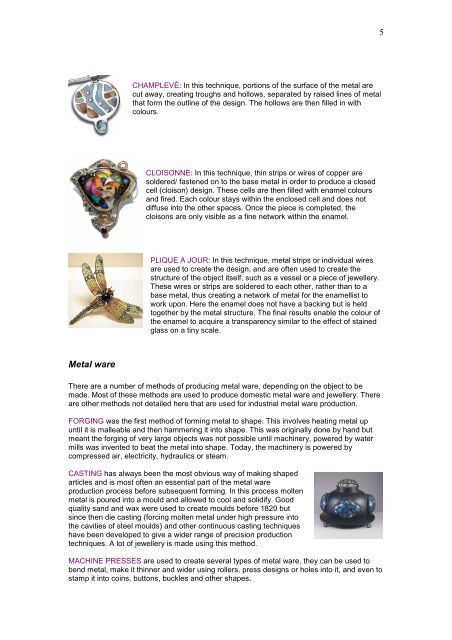Teacher's notes on Art Nouveau - Sainsbury Centre for Visual Arts
Teacher's notes on Art Nouveau - Sainsbury Centre for Visual Arts
Teacher's notes on Art Nouveau - Sainsbury Centre for Visual Arts
You also want an ePaper? Increase the reach of your titles
YUMPU automatically turns print PDFs into web optimized ePapers that Google loves.
Metal ware<br />
CHAMPLEVÉ: In this technique, porti<strong>on</strong>s of the surface of the metal are<br />
cut away, creating troughs and hollows, separated by raised lines of metal<br />
that <strong>for</strong>m the outline of the design. The hollows are then filled in with<br />
colours.<br />
CLOISONNE: In this technique, thin strips or wires of copper are<br />
soldered/ fastened <strong>on</strong> to the base metal in order to produce a closed<br />
cell (clois<strong>on</strong>) design. These cells are then filled with enamel colours<br />
and fired. Each colour stays within the enclosed cell and does not<br />
diffuse into the other spaces. Once the piece is completed, the<br />
clois<strong>on</strong>s are <strong>on</strong>ly visible as a fine network within the enamel.<br />
PLIQUE A JOUR: In this technique, metal strips or individual wires<br />
are used to create the design, and are often used to create the<br />
structure of the object itself, such as a vessel or a piece of jewellery.<br />
These wires or strips are soldered to each other, rather than to a<br />
base metal, thus creating a network of metal <strong>for</strong> the enamellist to<br />
work up<strong>on</strong>. Here the enamel does not have a backing but is held<br />
together by the metal structure. The final results enable the colour of<br />
the enamel to acquire a transparency similar to the effect of stained<br />
glass <strong>on</strong> a tiny scale.<br />
There are a number of methods of producing metal ware, depending <strong>on</strong> the object to be<br />
made. Most of these methods are used to produce domestic metal ware and jewellery. There<br />
are other methods not detailed here that are used <strong>for</strong> industrial metal ware producti<strong>on</strong>.<br />
FORGING was the first method of <strong>for</strong>ming metal to shape. This involves heating metal up<br />
until it is malleable and then hammering it into shape. This was originally d<strong>on</strong>e by hand but<br />
meant the <strong>for</strong>ging of very large objects was not possible until machinery, powered by water<br />
mills was invented to beat the metal into shape. Today, the machinery is powered by<br />
compressed air, electricity, hydraulics or steam.<br />
CASTING has always been the most obvious way of making shaped<br />
articles and is most often an essential part of the metal ware<br />
producti<strong>on</strong> process be<strong>for</strong>e subsequent <strong>for</strong>ming. In this process molten<br />
metal is poured into a mould and allowed to cool and solidify. Good<br />
quality sand and wax were used to create moulds be<strong>for</strong>e 1820 but<br />
since then die casting (<strong>for</strong>cing molten metal under high pressure into<br />
the cavities of steel moulds) and other c<strong>on</strong>tinuous casting techniques<br />
have been developed to give a wider range of precisi<strong>on</strong> producti<strong>on</strong><br />
techniques. A lot of jewellery is made using this method.<br />
MACHINE PRESSES are used to create several types of metal ware, they can be used to<br />
bend metal, make it thinner and wider using rollers, press designs or holes into it, and even to<br />
stamp it into coins, butt<strong>on</strong>s, buckles and other shapes.<br />
5


